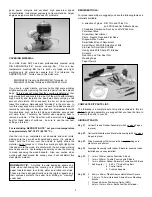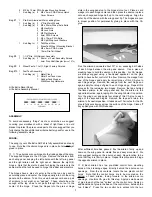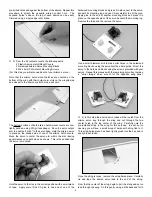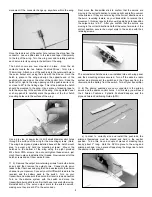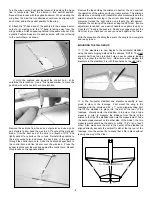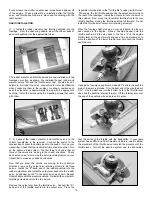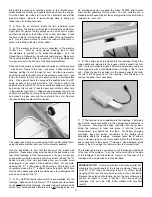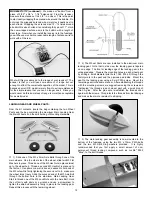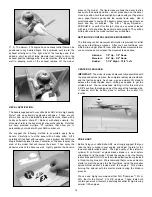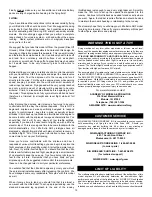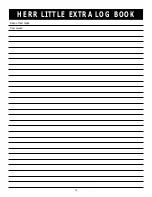
We used and recommend the Hitec
™
HS-55 Feather Servos for
this model. Of course you can use different brands of servos but
make sure they are the same size, weight, and output as the
HS-55 units.
IMPORTANT SERVO NOTE: The Hitec
™
HS-55 servos we used
in this kit all had off-the-shelf servo lead lengths of 10-1/2". This
meant that we did not have to add servo extensions to these
servos to reach the center of the wing. If you are using servos with
shorter leads, you will likely have to add servo lead extensions.
For receivers, we have used the Hitec
™
#555, the Hitec
™
Electron
6 and the FMA M5 units. All three of these receivers are dual
conversion types. These receivers are light, have excellent range
and, because they are dual conversion types, they are perfect for
use at any typical R/C flying field. We do not recommend using
single conversion receivers for this model.
We used a Hitec
™
270 mAh NiCad airborne battery pack for our
Little Extra models. In actual use, we found that after being fully
charged, we could fly for an honest 40 minutes or so before
needing to be recharged. The Y-harness is used to join the two
aileron servos and the 6" servo extension is required to connect
the ailerons to the receiver. We used the small Hitec
™
On/Off
switch assembly in the interest of weight and size.
Finally, the transmitter you use for this model is important. For our
Little Extra ARF models, we used both the Hitec
™
Flash 4 and the
Airtronics
®
RD-6000 transmitters.
Both of these affordable
systems offer multi-model memory and a host of easy-to-use
computer features that make radio set-up and flying a whole
easier and much more fun. If you do not use these transmitters or
similar units, the set-up and flying of your model is going to be
more difficult.
ENGINE SELECTION:
As previously mentioned, the Little Extra ARF was specifically
designed to fly very nicely using the Norvel
™
.074 BigMig R/C
engine. The use of this recommended engine provides really
1
INTRODUCTION
Congratulations on the purchase of the HERR ENGINEERING
Little Extra ARF kit! The Little Extra is one of the first true high
performance 1/2A fun-fly R/C type models to be available in an
Almost Ready to Fly format. Like larger fun-fly type sport models,
the Little Extra is loaded with a lot of features and truly
exhilarating performance potential.
The airframe is very light,
beautifully built and engineered to last a long time. The covering
has been professionally applied and the trim scheme is just about
perfect for this type of model. The assembly process is very quick
and further enhanced by the completeness of the kit.
Properly powered and flown, the Little Extra is a very capable
fun-fly type model! The airplane itself has been specifically
designed around the powerful little Norvel .074 BigMig R/C
engine. The kit includes a custom-cut motor mount assembly
specifically for this engine and even includes a custom aluminum
spinner insert for the spinner, designed to fit the .074 prop shaft.
In the air you will find it hard to believe that such a small model can
fly so "big". The Little Extra is fully capable of just about any R/C
maneuver you care to throw at it - point rolls, snaps, knife-edge,
inverted flight, lomcevaks, etc.
Who knew flying small gas
powered models could be so fun! Herr Engineering, that’s who.
To take full advantage of the Little Extra’s potential flight envelope,
we urge you to carefully review this Assembly Manual, paying
particular attention to the radio and battery equipment
suggestions.
These suggestions are based upon a lot of
experience with this design and should be heeded. The success
of this model is based upon its light ready-to-fly weight, so you
want to be sure your airborne equipment is as light as possible.
Finally, the Little Extra ARF design is not intended as a beginner's
R/C model. The design assumes that you are a proficient R/C
pilot, capable of flying relatively high-performance model aircraft.
RADIO EQUIPMENT
As mentioned previously, it is very important to select the correct
airborne radio equipment for your Little Extra ARF model. This
Assembly Manual will show the use of the following equipment.
This equipment is what we have used and can highly recommend
for the Little Extra ARF:
•
5 Micro Servos
(Hitec
™
HS-55 Servos used, (Hitec
™
P/N 31055*)
•
1 Micro Receiver
(see suggested receivers below)
•
1 270-300 mAh Airborne Battery Pack
(Hitec
™
P/N 57405*)
•
1 Hitec
™
Miniature Switch Harness
(Hitec
™
P/N 54403*)
•
1 Hitec
™
6" Y-Harness
(Hitec
™
P/N 57351*)
•
1 Hitec
™
6" Servo Extension
(Hitec
™
P/N 57344*)
(*With these part numbers you must specify the connector type for your radio system)


